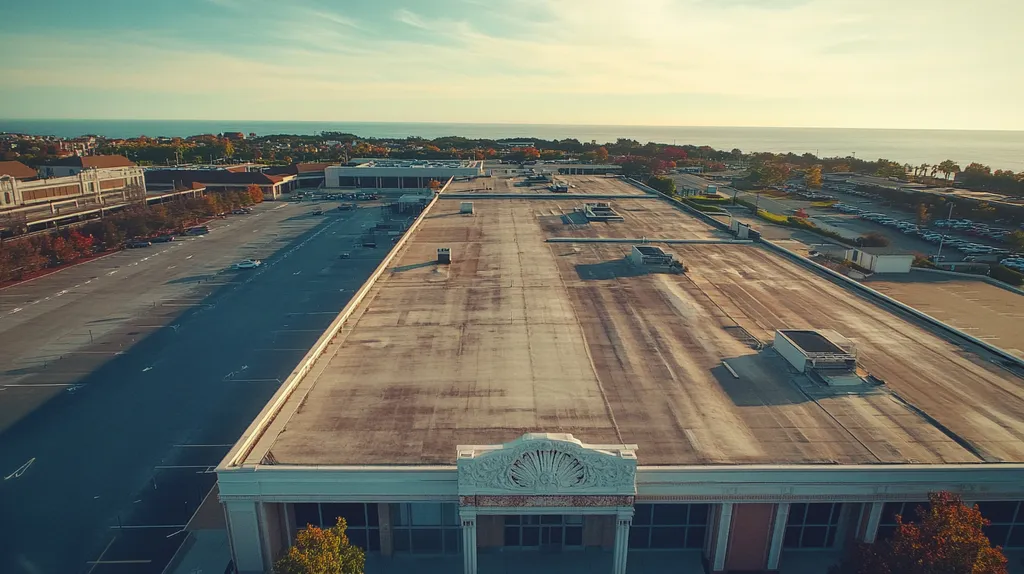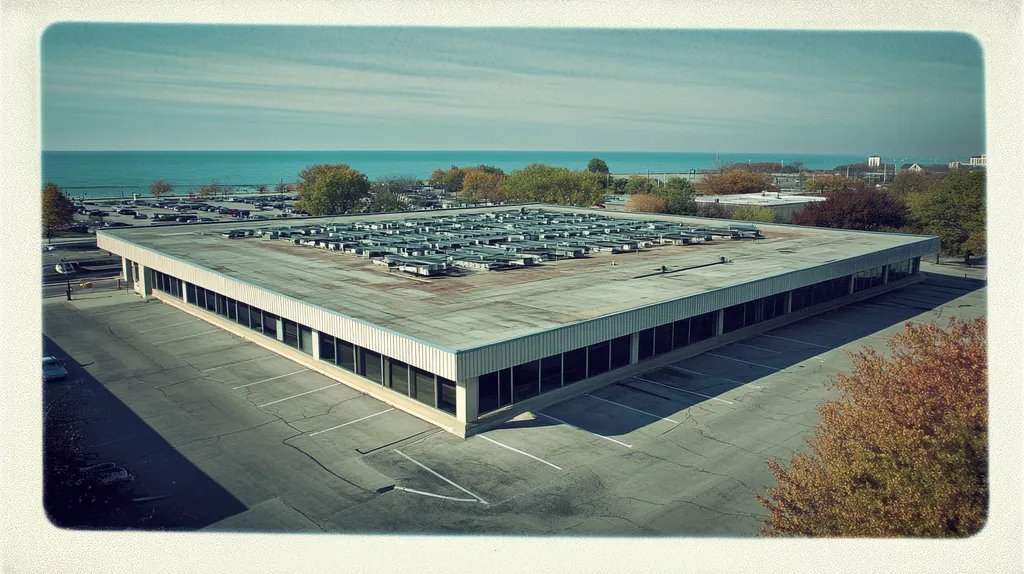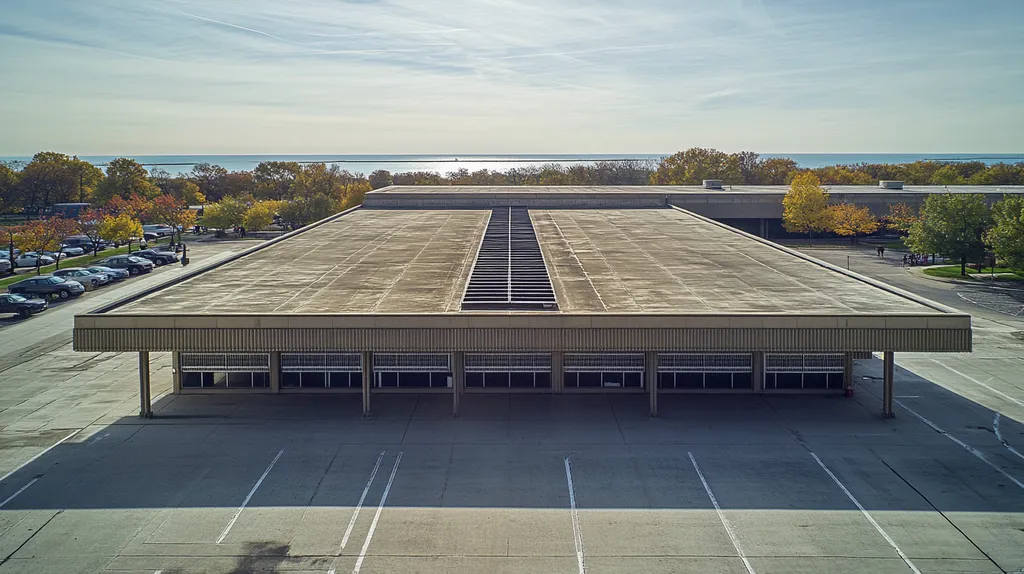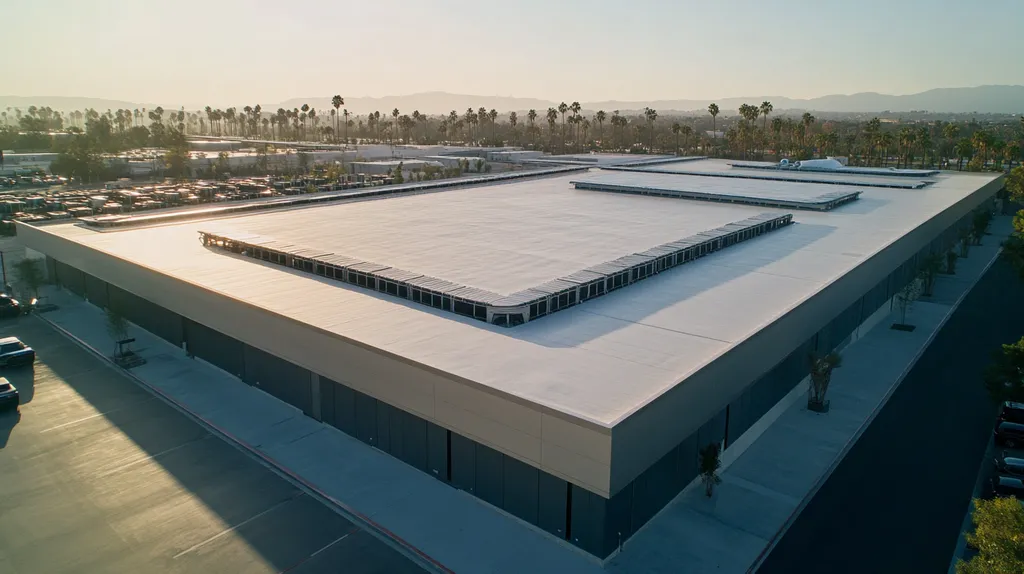Welcome to today’s Battle Royale featuring two roofing heavyweights: “TPO” in the east corner versus “PVC” in the west!
Tonight’s showdown pits these contenders against each other across six punishing rounds designed to test every aspect of their performance for state regulations affecting commercial roof warranties.
At stake? Millions in potential costs, decades of building protection, and the critical performance demands of modern commercial and industrial facilities.
Our professional judging panel will evaluate each round on technical merit, real-world performance, and value delivery. After all six rounds, we’ll declare our ultimate champion.
Ladies and gentlemen, facility managers and building owners… it’s time to rumble!
ROUND 1: INITIAL COSTS & INSTALLATION
When evaluating commercial roofing systems, the initial investment and installation process can make or break a project’s success. Recent market volatility has pushed material costs to unprecedented levels, making the choice between TPO and PVC more critical than ever. A misstep in selection can lead to budget overruns exceeding 30% and installation delays that cripple business operations.
Material Expenses
TPO and PVC represent opposite ends of the commercial roofing cost spectrum. TPO membranes typically cost $3.50-5.50 per square foot installed, making them an attractive option for budget-conscious property managers looking to maximize short-term capital.
PVC systems command premium pricing at $5.00-8.00 per square foot installed, reflecting their enhanced chemical resistance and durability. This higher entry point often causes sticker shock, especially on larger installations.
However, raw material costs tell only part of the story. TPO’s lower upfront investment comes with increased sensitivity to high temperatures and potentially shorter lifespans in challenging environments.
PVC’s superior resistance to chemicals, oils, and industrial pollutants can prevent costly remediation work down the line, potentially offsetting its higher initial cost in the right applications.
Installation Complexity
TPO installation stands out for its straightforward process and forgiving nature during application. The lighter weight materials and simpler welding requirements mean crews can cover more square footage per day with less specialized training.
PVC demands more technical expertise and precision during installation. The material’s rigid nature requires careful handling, and proper heat welding is critical to ensure watertight seams.
Weather conditions impact both systems differently during installation. TPO’s more flexible nature allows for easier installation in cooler temperatures, while PVC can become more challenging to work with.
Despite its complexity, PVC’s installation precision typically results in fewer callback issues and warranty claims, provided the crew is properly trained and experienced.
Project Timeline
TPO installations generally move at a rapid pace, with experienced crews capable of completing up to 10,000 square feet per day under optimal conditions. This efficiency minimizes business disruption and reduces labor costs.
PVC projects typically progress more slowly, averaging 6,000-8,000 square feet per day, due to the additional care required during installation. This extended timeline can impact project scheduling and coordination with other trades.
Weather delays affect both systems similarly, but TPO’s faster installation speed provides more flexibility in working around unfavorable conditions. This advantage can be crucial in regions with limited installation seasons.
While PVC installations take longer, the additional time investment often results in more reliable performance and fewer warranty claims, potentially reducing long-term maintenance disruptions.
ROUND 1 WINNER: TPO
ROUND 2: DURABILITY & LIFESPAN
In the high-stakes world of commercial roofing, durability isn’t just about avoiding leaks – it’s about protecting millions in assets and preventing catastrophic business disruptions. With warranty claims skyrocketing 40% in the last five years, the choice between TPO and PVC has never been more critical for property owners trying to navigate increasingly complex state regulations.
Material Composition and Durability
TPO’s chemistry relies on a blend of polypropylene and ethylene-propylene rubber, creating a flexible membrane that handles basic environmental stresses. Its reflective surface helps with temperature management, but prolonged exposure to high heat can accelerate aging and potentially compromise seam integrity.
PVC brings industrial-grade toughness through its unique molecular structure, featuring chlorine atoms that create exceptional chemical resistance. This composition allows it to shrug off industrial pollutants, grease exposure, and harsh cleaning chemicals that would deteriorate other materials.
Temperature fluctuations hit TPO harder, with some formulations showing signs of premature aging in hot climates. Meanwhile, PVC maintains consistent performance across temperature extremes, though it comes with a higher price tag.
For pure durability against environmental and chemical assault, PVC holds a clear ADVANTAGE.
Weather Resistance and Performance
TPO membranes offer solid UV resistance and generally good weathering characteristics in moderate climates. However, their performance can become unpredictable in regions with extreme temperature swings or heavy industrial pollution.
PVC’s track record in extreme weather conditions is exceptional, particularly in areas with high rainfall or severe storms. Its hot-air welded seams create monolithic surfaces that resist water infiltration better than TPO’s mechanically fastened or adhesive-bonded joints.
While both materials handle basic weather conditions adequately, PVC’s superior seam strength and proven longevity in harsh environments give it an ADVANTAGE.
Warranty Coverage and Compliance
TPO warranties typically range from 15-20 years, but state regulations increasingly demand proof of extended performance history. Some manufacturers have started reducing coverage terms in response to premature failures in challenging environments.
PVC systems routinely carry 20-30 year warranties, backed by decades of documented performance data that satisfies even the strictest state requirements. The material’s established track record makes it easier for building owners to secure extended coverage options.
Beyond basic warranty terms, PVC’s documented resistance to chemical exposure and environmental stressors helps facilities maintain compliance with evolving environmental protection regulations.
When it comes to meeting warranty requirements and regulatory compliance, PVC demonstrates another clear ADVANTAGE.
ROUND 2 WINNER: PVC
ROUND 3: PERFORMANCE FACTORS
In today’s volatile commercial roofing market, performance factors can make the difference between a 30-year success story and a warranty nightmare. With material costs up 40% since 2020 and warranty claims hitting record highs, choosing between TPO and PVC has become a high-stakes gamble that impacts every aspect of building operations.
Chemical Resistance
Chemical exposure represents one of the most insidious threats to commercial roofing systems. From HVAC coolants to kitchen grease, modern buildings subject their roofs to a constant barrage of potentially damaging substances.
TPO offers moderate chemical resistance, handling basic exposure to common pollutants and cleaning solutions. However, prolonged contact with industrial solvents, oils, or animal fats can degrade the membrane over time, potentially voiding warranty coverage.
PVC’s molecular structure creates exceptional resistance to chemicals, acids, and oils. This inherent protection extends across the entire membrane surface and seams, maintaining warranty compliance even in harsh industrial environments.
For chemical resistance, PVC demonstrates a clear ADVANTAGE.
Fire Safety and Code Compliance
Modern building codes demand increasingly stringent fire safety ratings from roofing materials. The stakes couldn’t be higher – a single fire-related incident can trigger catastrophic liability and insurance complications.
TPO membranes typically achieve Class A fire ratings through added fire retardants, though performance can vary between manufacturers. Some formulations may require additional protective layers to meet local code requirements.
PVC’s inherent chlorine content makes it naturally fire-resistant without requiring additional chemicals. This self-extinguishing property ensures consistent fire safety performance throughout the membrane’s lifespan.
When it comes to fire safety compliance, PVC holds another ADVANTAGE.
Impact and Puncture Resistance
Rooftop traffic, falling debris, and maintenance activities create constant threats to membrane integrity. A single puncture can compromise the entire system and trigger extensive warranty investigations.
TPO’s flexibility allows it to absorb impacts without cracking, particularly in thicker formulations. The material’s natural elasticity helps it resist punctures from typical rooftop hazards and foot traffic.
PVC tends to be more rigid, which can make it more susceptible to puncture damage from sharp impacts. While premium formulations offer enhanced protection, basic PVC systems may require additional reinforcement in high-traffic areas.
For impact resistance, TPO claims the ADVANTAGE.
ROUND 3 WINNER: TIE
ROUND 4: MAINTENANCE REQUIREMENTS
In today’s complex regulatory landscape, maintenance requirements can make or break a commercial roof’s warranty coverage. With state regulations becoming increasingly stringent, a single missed inspection or improperly documented repair can void coverage worth hundreds of thousands of dollars. Property owners face a critical choice between TPO and PVC systems, each carrying distinct maintenance obligations that directly impact long-term liability and compliance.
Impact of Warranty Regulations on Maintenance
State regulations increasingly demand rigorous documentation of maintenance activities to maintain warranty coverage. Recent changes in multiple jurisdictions have established strict inspection schedules and reporting requirements that directly affect both TPO and PVC systems.
TPO membranes typically require quarterly inspections in most jurisdictions, with detailed documentation of seam conditions and membrane integrity. These requirements align with manufacturer warranties but can create significant administrative overhead for facility managers.
PVC systems generally permit longer intervals between mandatory inspections, often allowing semi-annual checks in many states. This reduced frequency stems from PVC’s proven track record of durability and chemical resistance.
For regulatory compliance and documentation requirements, PVC shows an ADVANTAGE due to its less demanding inspection schedule.
Routine Maintenance Duties
Daily operations and environmental factors create constant maintenance challenges for commercial roofs. Understanding these ongoing requirements is crucial for maintaining warranty compliance and preventing premature system failure.
TPO maintenance focuses heavily on seam inspection and repair, requiring specialized knowledge and equipment. Regular cleaning is essential to maintain reflectivity and prevent chemical damage that could compromise warranty coverage.
PVC systems demand less frequent attention to seams due to their superior weld strength and chemical resistance. However, when repairs are needed, they often require more specialized expertise and materials.
In terms of routine maintenance requirements, TPO shows an ADVANTAGE due to simpler repair procedures and more readily available maintenance materials.
Cost of Maintenance Over Time
Long-term maintenance costs significantly impact the total ownership expense of commercial roofing systems. Recent market analysis shows maintenance expenses can exceed initial installation costs over a typical warranty period.
TPO systems generally incur higher annual maintenance costs due to more frequent inspection requirements and seam repairs. These expenses can accumulate rapidly, especially in regions with extreme weather conditions.
PVC roofs typically show lower long-term maintenance costs, primarily due to their superior durability and chemical resistance. While individual repairs may cost more, they occur less frequently throughout the system’s lifespan.
For ongoing maintenance expenses, PVC demonstrates an ADVANTAGE through reduced frequency of repairs and longer intervals between required maintenance activities.
ROUND 4 WINNER: PVC
ROUND 5: SUSTAINABILITY CREDENTIALS
With new environmental regulations hitting the commercial roofing industry every quarter, sustainability credentials have become make-or-break factors for warranty compliance. Recent changes in state policies have triggered a 45% increase in sustainability-related warranty disputes, forcing property owners to reevaluate their roofing choices or risk significant financial penalties.
Environmental Impact
TPO membranes offer impressive environmental benefits through their highly reflective surface and energy-efficient properties. Studies show TPO roofs can reduce cooling costs by up to 30% in warm climates, helping buildings meet increasingly strict energy consumption regulations.
PVC production generates concerning levels of dioxins and other harmful chemicals, raising red flags with environmental regulators. While manufacturers have improved their processes, PVC’s fundamental chemistry still poses challenges for facilities trying to meet stricter environmental standards.
Most TPO membranes are fully recyclable at end-of-life, while PVC often ends up in landfills due to limited recycling options. This difference significantly impacts a building’s overall environmental footprint and compliance with waste reduction mandates.
For environmental impact, TPO claims a clear ADVANTAGE.
Regulatory Compliance
TPO systems typically meet or exceed current environmental standards across all 50 states. Their clean manufacturing process and minimal chemical emissions help facilities maintain compliance with evolving air quality regulations.
PVC faces mounting scrutiny from state environmental agencies due to its chlorine content and production byproducts. Some jurisdictions have already implemented restrictions on PVC construction materials, signaling potential future challenges for warranty coverage.
The regulatory landscape clearly favors TPO’s simpler chemical composition and lower environmental impact. This advantage becomes particularly important as states continue strengthening their environmental protection requirements.
In regulatory compliance, TPO demonstrates another ADVANTAGE.
Energy Performance
TPO’s highly reflective surface maintains its solar reflectance index (SRI) rating longer than most alternatives. This sustained performance helps buildings consistently meet energy efficiency requirements without costly membrane treatments or replacements.
PVC systems can achieve similar initial reflectivity values but often require more frequent cleaning and maintenance to maintain their energy performance. This degradation can impact both warranty coverage and compliance with energy efficiency standards.
While both materials meet basic energy efficiency requirements, TPO’s superior long-term performance and lower maintenance needs give it an ADVANTAGE in this category.
ROUND 5 WINNER: TPO
ROUND 6: SPECIALIZED APPLICATIONS
In today’s high-stakes commercial roofing market, specialized applications can make or break a building’s warranty compliance. With state regulations tightening around specific use cases and environmental zones, choosing between TPO and PVC has become increasingly complex. A single misstep in material selection can trigger cascading compliance issues that void coverage and lead to six-figure remediation costs.
Industrial Environment Performance
Industrial facilities present unique challenges that push roofing materials to their absolute limits. Exposure to chemicals, extreme temperatures, and atmospheric pollutants can rapidly degrade standard roofing systems and void warranties.
TPO offers moderate resistance to basic industrial pollutants but struggles with prolonged exposure to harsh chemicals and high-temperature exhaust. In demanding industrial settings, TPO’s performance limitations often require additional protective coatings to maintain warranty compliance.
PVC thrives in industrial environments, with superior resistance to chemicals, oils, and industrial emissions. Its molecular structure provides natural protection against most industrial contaminants without requiring supplemental treatments.
For industrial applications, PVC demonstrates a clear ADVANTAGE.
Solar Integration Requirements
The surge in commercial solar installations has created new challenges for roofing warranties. Modern solar arrays introduce additional penetrations, weight loads, and maintenance requirements that test membrane durability.
TPO’s flexibility and lighter weight make it well-suited for solar installations. The material easily accommodates mounting systems and maintains its integrity around numerous penetrations.
PVC’s rigidity can complicate solar installations and increase the risk of stress points around mounting hardware. While durable, PVC requires more careful planning and execution when integrating solar components.
For solar integration, TPO claims the ADVANTAGE.
Restaurant and Food Service Applications
Commercial kitchen exhaust and food processing facilities create some of the most challenging environments for roofing systems. Constant exposure to greases, oils, and cleaning chemicals can rapidly deteriorate standard membranes.
TPO shows significant vulnerability to kitchen exhaust contaminants, often requiring frequent cleaning and maintenance to prevent premature degradation. Extended exposure to animal fats and cooking oils can compromise seam integrity and void warranty coverage.
PVC’s superior chemical resistance makes it the ideal choice for restaurant applications. Its proven performance against greases and oils helps maintain warranty compliance even in the harshest kitchen environments.
For food service applications, PVC holds another clear ADVANTAGE.
ROUND 6 WINNER: PVC
AND THE WINNER IS…
After six grueling rounds of technical analysis and regulatory scrutiny, we have our champion! With victories in Rounds 2, 4, and 6, plus a tie in Round 3, PVC claims the title in a split decision over TPO!
PVC dominated the crucial categories of durability, maintenance requirements, and specialized applications. Its superior chemical resistance, longer inspection intervals, and exceptional performance in demanding industrial environments proved decisive in securing the championship belt.
But don’t count TPO out! This resilient contender showed impressive strength in initial costs, sustainability credentials, and solar integration capabilities. For properties in moderate climates with tight budgets and green building requirements, TPO remains a formidable choice.
Important Ringside Notice: Every building faces unique challenges that can impact roofing performance. Local climate conditions, regulatory requirements, and specific facility characteristics all play crucial roles in determining the ideal system. This analysis provides general guidance but cannot account for all variables. Property owners should always consult qualified roofing professionals who can evaluate their specific situation.
Ladies and gentlemen, in the high-stakes arena of commercial roofing, there’s no substitute for matching your facility’s unique demands with the right contender’s strengths. Choose wisely – your warranty coverage depends on it!
FREQUENTLY ASKED QUESTIONS
Q. What are the commercial roof costs for TPO and PVC?
A. TPO systems usually cost between $3.50-$5.50 per square foot installed, while PVC systems run $5.00-$8.00. The upfront investment for TPO can look appealing, but the long-term performance may betray your budget if the wrong choice is made.
Q. How do state regulations affect commercial roof durability?
A. Durability regulations affect warranty claims, particularly for TPO and PVC roofing. Recent increases in warranty claims demonstrate the high stakes of choosing the wrong material, as compliance with state regulations often hinges on proven durability.
Q. What commercial roof performs better in extreme weather?
A. PVC performs consistently in extreme weather conditions, while TPO can falter under high temperatures. The monolithic seams of PVC make it superior in preventing water infiltration during storms, offering peace of mind for property owners.
Q. How does maintenance differ between TPO and PVC commercial roofs?
A. TPO generally requires more inspections and specific maintenance tasks, while PVC allows longer inspection intervals. This means property managers need to be more vigilant with TPO to avoid warranty voids, especially with state regulations tightening.
Q. Which commercial roof is more sustainable?
A. TPO stands out for its environmental benefits, offering better recycling options and energy efficiency. In contrast, PVC’s production raises flags due to environmental impacts, making TPO the clear winner in sustainability credentials.
Q. How do TPO and PVC perform in specialized applications?
A. PVC excels in industrial environments due to its chemical resistance. TPO can struggle under severe conditions, often requiring additional protection, which makes PVC better suited for specialized applications in those settings.
Q. What is the warranty coverage for commercial roof systems?
A. TPO warranties usually last 15-20 years, while PVC often covers 20-30 years. The longer warranty on PVC, combined with its compliance history, makes it easier for building owners to navigate the regulatory landscape.











